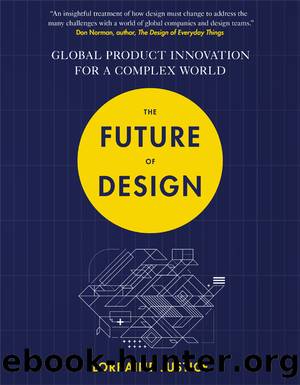The Future of Design by Lorraine Justice

Author:Lorraine Justice
Language: eng
Format: epub
Publisher: Quercus
City Headquarters, Suburban Campus, Both or Neither
City headquarters and suburban campuses seem to be the two main types of spaces that attract companies. However, there are signs that these environments may change in the future as communication software grows, cities become costlier, and the need for physical space declines. Yet as seen in the next section, some cities are planning for the future and making updates in order to remain attractive to companies.
The Responsive City Space
Cities weren’t always designed around people. They were often designed around transportation needs, whether it was horse and cart or automobile. Many cities grew up around a castle, distribution center, or a manufacturing plant. Anne Stenros, Helsinki’s first chief design officer, believes cities should be designed around people.3 Stenros says that planning and designing cities should involve design for the “greater good,” with future generations in mind. “Cities will evolve from being ‘smart’ to being ‘responsive.’ . . . The city could and should proliferate an abundance of ideas, inspiration, and creativity for all kinds of people.”4
Responsive cities of the future can give back to their inhabitants in many ways. In the future, sensing technologies and other technologies in the infrastructure of cities that can connect to personal devices will become more common. Technologies and responsive cities can help people navigate more easily, stay safe, and become aware of events, entertainment, education opportunities, or open parking spots. Imagine you are heading into a high-crime area, and you receive an alert to avoid the area. Or maybe you receive an alert that a friend of yours is nearby. Some of these options are available today, but they are not widespread.
Alexander and Jochen Renz, managing partners of New Mobility Consulting, advise corporations, start-ups, and investors on how to thrive in this future by rethinking city design and car ownership.
“As we explore the future of mobility, we take a holistic view of the emerging ecosystem of mobility far beyond the traditional automotive value chain. We believe that mobility as a service has profound implications on public transportation, car dealers, aftermarket service, and insurance but also real estate and other sectors. In fact, redesigning mobility and transportation will lead to a redesign of cities as we can reclaim parking space to create more livable and vibrant cities with pedestrian zones, street cafes, parks, and playgrounds.
In light of connected, autonomous, shared and electric vehicles, the world of mobility and transportation is undergoing unprecedented change. Exponential technologies will enable new business models that will transform traditional industry value chains into a new mobility ecosystem. New business models emerge that will fundamentally alter how we as consumers think about consuming mobility (and car ownership).”5
Download
This site does not store any files on its server. We only index and link to content provided by other sites. Please contact the content providers to delete copyright contents if any and email us, we'll remove relevant links or contents immediately.
| Decorative Arts | Design History & Criticism |
| Furniture Design | Industrial & Product Design |
| Interior & Home Design | Jewelry Design |
| Textile & Costume |
POP by Steven Heller(2883)
Japanese Design by Patricia J. Graham(2556)
The Power of Broke by Daymond John(2376)
Architecture 101 by Nicole Bridge(2350)
Fusion 360 for Makers by Lydia Sloan Cline(1987)
Indistractable: How to Control Your Attention and Choose Your Life by Nir Eyal(1936)
Origami Art by Michael G. Lafosse & Richard L. Alexander(1735)
Actionable Gamification: Beyond Points, Badges, and Leaderboards by Yu-kai Chou(1721)
Batik by Rudolf Smend(1720)
Homebody by Joanna Gaines(1711)
Worn in New York by Emily Spivack(1618)
Feng Shui by Stephen Skinner(1616)
Whiskey in a Teacup by Reese Witherspoon(1576)
Austin Kleon by Steal Like an Artist(1537)
Don't Make Me Think, Revisited: A Common Sense Approach to Web Usability by Steve Krug(1527)
Simple Gatherings by Melissa Michaels(1511)
Hygge: The Danish Art of Happiness by Marie Tourell Søderberg(1428)
The Joy of Hygge by Jonny Jackson(1341)
The Laws of Simplicity by John Maeda(1300)
